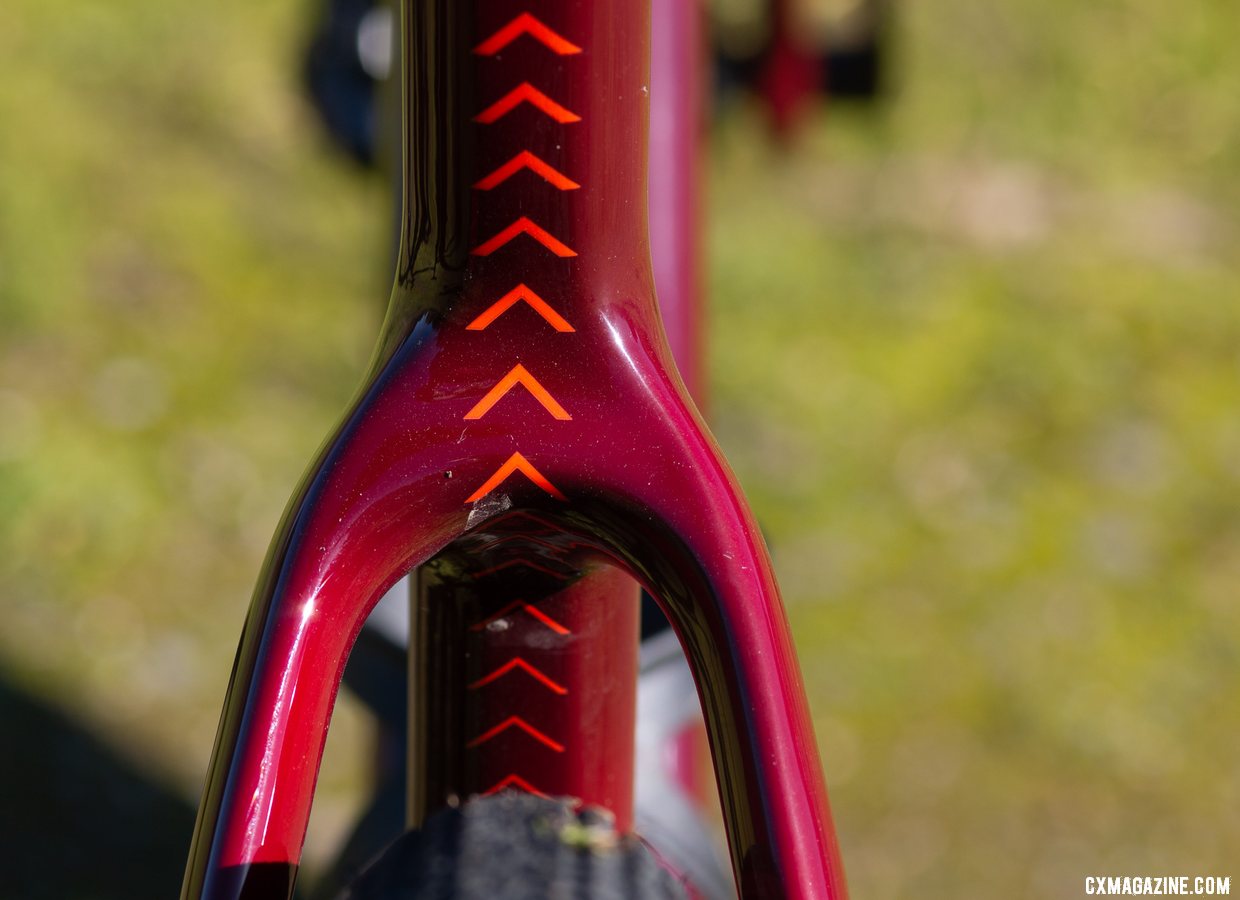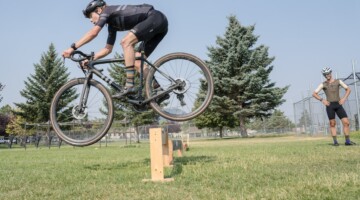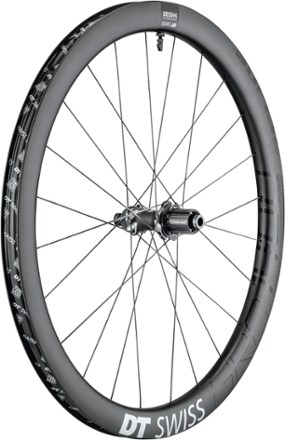
The Cervelo Aspero eschews frame barnacles and bikepacking for all-road handling and race-tailored design. © A. Yee / Cyclocross Magazine
Cervelo has always been a road brand. Although when co-founder Gerard Vroomen left to start Open Cycle his first two projects were dirt focused, Cervelo has never thrown its hat in the ring to offer a cyclocross or gravel bike on the mass market. Despite a one-off production that modified the R3, a road bike designed for cobbled classics, and custom carbon cyclocross bikes for four-time National Champ Jonathan Page, a commercially available Cervelo for the dirt never came to be.
While the C series was a step in that direction, with wider tires and more relaxed geometry than the traditional and aero road bikes that make up the bulk of the brand’s drop bar offerings, it is still very much a road-focused bike. All that changed in 2019 when Cervelo released the Aspero, a gravel race bike that draws on the brand’s road racing heritage to create a race-specific frame for mixed surfaces. We have seen the Aspero raced at the top level in Europe by Joris Nieuwenhuis, whose Sunweb team took on Cervelo as a bike sponsor to replace Giant and the TCX.
There are five builds for the Aspero starting at $2800 with SRAM Apex 1 and the Force AXS build we received is the top tier package at $6000. Cervelo also sells a frameset for $2500. That means you get a full build kit for $300 if you pick Apex 1!
The Cervelo Aspero Frame
Cervelo designed the full carbon frame and fork from the ground up to be a stripped-down race bike. With only three bottle cage mounts and a top tube bag mount, the Aspero will not accept racks, fenders or racks.

The Cervelo Aspero carbon gravel bike is ready for a top tube snack box, but not racks or fenders. Careful, the top tube bag mount cover wants to fly off when flying on car racks. © Cyclocross Magazine
The frame features internal cable routing for 1x and 2x drivetrains and has a removable front derailleur mount.

Front mech or no? The Aspero can go either way. The Cervelo Aspero carbon gravel bike review. © Cyclocross Magazine
The frame has a sizeable down tube and chainstay guard to protect it from errant rocks and chain slap on rough terrain. As always with Cervelo, the frame uses the asymmetric BBRight bottom bracket standard.
The frame is compatible with up to 700x42mm or 650x49mm tires. Additionally, Cervelo designed the Aspero fork to adapt to the difference in the mechanical trail between the two wheel sizes. To accomplish this, the Trail Mixer dropout is adjustable by 5mm, which compensates for the difference in wheel radius and provides the same nominal mechanical trail for both wheel sizes.

The Cervelo Aspero’s fork features a Trail Mixer chip that allows for a 5mm change in offset/rake. © Cyclocross Magazine
Cervelo recommends the shorter Trail Mixer setting for road tires on 700c wheels, which actually results in more trail and less offset, but the smaller tires would offset this change with reduced trail.
The Aspero is quite roomy. Our size 56 has a stack of 580mm and a reach of 397, with a wheelbase of 1027mm. Those measurements are formed thanks to a head angle of 72 degrees and a seat angle of 73 degrees. The biggest change from modern cyclocross geometry is down below, with its short 420mm chainstay and a bottom bracket drop of 76mm. Think that’s too low? Nieuwenhuis uses an eccentric bottom bracket for more clearance for his bunnyhopping and off-camber attacks. Notably, the bottom bracket becomes higher as frame size increases.

Aspero means “rough” in Spanish, but the hose and housing routings are anything but. The Cervelo Aspero carbon gravel bike review. © Cyclocross Magazine
What does it all weigh? Cervelo reports its 56cm frame weighs 1110g with paint, cable guides and frame protectors. The fork, complete with the Trail Mixer hardware, weighs 450g. These weights won’t wow weight weenies, but certainly provide the foundation for a relatively lightweight race machine. Our complete bike weighed under 18 pounds.
Cervelo Aspero: The SRAM AXS Force Build
Our Aspero uses the top-level SRAM Force AXS 1 build, using the Chicago brand’s wireless 12-speed drivetrain. The $6000 bike is equipped out of the box with a SRAM Force DUB crank and a 36t direct mount chain ring.

The 36×33 low gear on the Force AXS build was ideal for cyclocross, but quite tall for hilly gravel rides. The Cervelo Aspero carbon gravel bike review. © Cyclocross Magazine
The 10-33t cassette that comes with the bike is the widest available when using the Force AXS derailleur. The 36 x 33 low gear is quite tall for gravel, but arguably perfect for cyclocross. The bottom bracket is also SRAM DUB, in press-fit BBRight.

The Cervelo Aspero SRAM AXS eTap Force 1x drivetrain offers a great gear range for cyclocross but not gravel. © Cyclocross Magazine
It’s worth noting that when the chain is in the 36 x 10 gear, it barely clears the chainstay. Cervelo includes a beefy rubber chainstay protector, and the Force AXS rear derailleur has a fluid damper, but the chain is uncomfortably close to our eyes.

The SRAM Flattop chain barely clears the seatstay when in the 36×10 gear. The Cervelo Aspero carbon gravel bike review. © Cyclocross Magazine
There are Apex 1, Shimano Ultegra 2x, GRX 2x and GRX 1x build options as well, ranging from $2800 to $4200. All of these build options feature a 1:1 or lower low gear.
Wheels are DT Swiss GRC 1650, which are carbon and designed expressly for gravel use. Interestingly, the model does not appear in the DT Swiss catalog yet and is a Cervelo-specific version of the GRC 1400 carbon wheelset, with a 43mm-deep rim that’s 24mm internally wide. These wheels save a few dollars over the 1400 due to their DT 370 hubs, as opposed to the DT 350 hubs on the GRC 1400 model. While we haven’t yet weighed the wheels by themselves, DT Swiss’ 700c version of the GRC 1400 weighs 1634g, for comparison. We suspect these will be slightly heavier. Cervelo equips the DT Swiss wheels with SRAM Centerline XR rotors in 160mm and tan wall Donnelly MSO tubeless-ready tires in 700x40mm.

Cervelo teamed with DT Swiss for its own version of the GRC 1400 carbon gravel wheel. The GRC 1650 features different hubs but the same rim. The Cervelo Aspero carbon gravel bike. © Cyclocross Magazine
Cockpit components come from Easton, with carbon EC70 AX handlebars and an EC70 seat post. The stem is an Easton EA90. The saddle is a Prologo Dimension NDR T4.0 which features a snub-nosed design that has become popular in recent years. Additionally, the bike includes an Easton computer mount designed to interface seamlessly with the stem.

The excellent EC70 AX carbon bar handles the steering. The Cervelo Aspero carbon gravel bike. © Cyclocross Magazine
The Aspero Ride
Cervelo may not be marketing this bike as a do-it-all bike or a cyclocross race bike, but don’t let that convince you this bike is only good for gravel roads. Marketing’s responsibility is to build perception among those who haven’t yet ridden the bike. Thankfully, we’ve got a few weeks on the bike and have some initial impressions. And the first impression is that the Aspero is quite capable handling more terrain than gravel, with stiff, race-oriented efficiency. Perhaps it’s fitting that its Spanish name translates to “rough.”

The Cervelo Aspero is ready for cyclocross, fast gravel and the road. © A. Yee / Cyclocross Magazine
First, the Aspero hits its mark in that it’s well-suited for gravel racing. It doesn’t ride like a bikepacking bike or an adventure bike, but more like a slightly stretched-out and slackened carbon road bike. It’s stiff and well-suited for high-speed, smooth gravel roads, and welcomes all-out sprints on the flat and up hills.
The Aspero, thanks to its short 42cm chainstays, climbs like a goat. That’s not only up loose gravel hills, but also pedaling up slippery run-ups that threaten to force you off your bike due to rear-wheel slip.
Thankfully, the Aspero’s carbon mold doesn’t compromise tire clearance despite its short chainstays. The curved trailing edge of the seat tube, the 79mm-wide BBRight bottom bracket shell and wide chainstay junction offer ample clearance around the stock 40mm gravel tires, and generous clearance around 33mm cyclocross tires, which came in handy in a muddy cyclocross race. We often prefer gravel bikes over cyclocross “race” bikes on muddy days, simply because they typically have superior tire clearance. That tire clearance becomes invaluable mud clearance, and keeps those of us without pit crews rolling to the finish. This accurately describes the Aspero.

The Cervelo Aspero carbon gravel bike has ample clearance around 40mm gravel tires, and lots of mud clearance around 33mm cyclocross tires. © Cyclocross Magazine
Think the Aspero’s gravel orientation means it can’t handle your adventures inside the course tape? Nieuwenhuis doesn’t seem to struggle racing his “gravel” bike at the highest UCI level, but our experience racing and riding the bike suggests that Aspero shines on faster courses. Got a grass crit or race with a lot of fast hardpack dirt? The long, roomy geometry drops you in the perfect position to attack such a course with speed.
Find yourself in low-speed, technical terrain with a lot of tight turns? You might prefer a tighter wheelbase and a higher bottom bracket, but don’t assume the Aspero is an 18-wheeler on the rough stuff. Its front-end geometry has about 3mm less trail than the slightly-shorter reach 56mm Specialized Crux or Cannondale SuperX, and far less than a Kona Major Jake.
Speaking of trail, the TrailMixer fork offers a 5mm adjustment in trail/offset. It’s a binary choice, without incremental adjustments like a horizontal dropout offers, but it allows multi-discipline or multi-wheel-size cyclists to tweak handling based on expected terrain or wheel size. Stay tuned as we spend more time going through the permutations available. It’s a feature we might use if we were to swap between 700c and 650b wheels regularly.
As for that low bottom bracket, while it was low enough to motivate Nieuwenhuis to raise it through an eccentric assembly, it wasn’t a major issue in all of our riding. Low bottom brackets can be problematic due to pedal strikes on off-cambers or roots, or because of increased chainring strikes when hopping the barriers. Most riders won’t encounter either issue, but thanks to SRAM’s 36t chain ring on the SRAM AXS eTap Force group, the barrier-hopping clearance quite generous.
Is the Aspero right for you? If you’re looking for a bike for bikepacking with 50mm gravel tires, you should look elsewhere. If you need a rig to slay technical, tight singletrack, you’ll probably disappointed. But if you like racing gravel, and also might want to jump into cyclocross races with the same bike, the Aspero is definitely worth a look. If cyclocross is your thing and you don’t often face mud, you might like the 36/10-33 12-speed SRAM AXS eTap Force gearing, but hilly gravel rides are in your future, you may prefer the gearing range of the SRAM Apex or Shimano build options.
Stay tuned as we complete our long-term test and try the Aspero with different wheels, tires and Trail Mixer settings.
See the full photo gallery below the specs.
Brandon Grant and Andrew Yee contributed to this review.
Cervelo Aspero Force 1 AXS Full Specs:
MSRP: $6000
Frame: Cervelo Aspero, full carbon, BBRight, internal cable routing, flat mount disc, 12x142mm thru-axle
Fork: Cervelo Aspero, 12x100mm thru-axle, tapered full carbon steerer, flat mount disc, Trail Mixer flip chip
Shift/Brake Levers: SRAM Force eTap AXS Shift-Brake Levers
Brake Calipers: SRAM Force eTAP AXS HRD, flat mount disc
Rotors: SRAM Centerline XR, 160mm
Crankset: SRAM Force 1 AXS, 170mm crank arms
Chain Ring: SRAM X-Sync 2, 36t
Rear Derailleur: SRAM Force eTap AXS
Cassette: SRAM Force eTap AXS, 10-33t
Chain: SRAM Force Flattop
Wheels: DT Swiss GRC 1650 Disc, carbon, tubeless-ready, 24mm wide
Tires: Donnelly X’Plor MSO, tan wall, tubeless-ready, 700c x 40mm
Stem: Easton EA90, alloy
Handlebar: Easton EC70AX, flared drops, carbon
Seatpost: Easton EC70, carbon
Saddle: Prologo Dimension NDR T4.0
Weight: 17.7 pounds without pedals, 10.7 pounds without wheels
More info: cervelo.com
Cervelo Antero Carbon Gravel Bike Photo Gallery:

































